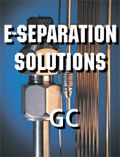Ask the Editor: Replacing Acetonitrile
The answer to the following question was provided by LCGC's "LC Troubleshooting" columnist John Dolan. Q: Since acetonitrile is in short supply and the prices have sky-rocketed in recent months, what can be done about replacing this solvent with others for various chromatography applications?
The answer to the following question was provided by LCGC’s “LC Troubleshooting” columnist John Dolan.
Q: Since acetonitrile is in short supply and the prices have sky-rocketed in recent months, what can be done about replacing this solvent with others for various chromatography applications?
A: Unfortunately, there is no solvent that is a simple replacement for acetonitrile. It will require a rework of the method — perhaps with a change in the column, but certainly the mobile phase organic solvent and perhaps additives.
A better alternative to pursue is acetonitrile conservation. Most liquid chromatography systems can be used quite well with 2.1 mm i.d. columns. So a 150 mm x 4.6 mm column operated at 1 mL/min can be replaced with a 150 mm x 2.1 mm column at 0.2 mL/min. A further savings can be accomplished by going from a 150-mm, 5-µm particle column to a 100-mm, 3-µm particle column, for a reduction in retention time of 30%. The combination of these should reduce solvent consumption to 100/150 x 0.2/1 = 13% of the original. And most well-plumbed conventional systems can accommodate this without the added expense of new equipment. And there is an added bonus of increased sensitivity (peak height) if you can load the same mass on the column (may or may not be true).
Questions?
LCGC technical editor Steve Brown will answer your technical questions. Each month, one question will be selected to appear in this space, so we welcome your submissions. Please send all questions to the attention of "Ask the Editor" at lcgcedit@lcgcmag.com We look forward to hearing from you.

Determining Neurotransmitters in Spinal Cords with UHPLC
February 18th 2025Researchers at Jilin University (Changchun, China) developed a highly sensitive, rapid, and accurate method for analyzing neurotransmitters (NTs) in rat spinal cord tissue. Ultra-high performance liquid chromatography-triple quadrupole tandem mass spectrometry (UHPLC-QqQ-MS/MS) in conjunction with ultra-ionic liquid dispersive liquid-liquid microextraction (UA-MIL-DLLME) were used to extract NTs for analysis.
The Next Frontier for Mass Spectrometry: Maximizing Ion Utilization
January 20th 2025In this podcast, Daniel DeBord, CTO of MOBILion Systems, describes a new high resolution mass spectrometry approach that promises to increase speed and sensitivity in omics applications. MOBILion recently introduced the PAMAF mode of operation, which stands for parallel accumulation with mobility aligned fragmentation. It substantially increases the fraction of ions used for mass spectrometry analysis by replacing the functionality of the quadrupole with high resolution ion mobility. Listen to learn more about this exciting new development.
Revolutionizing LC-MS with Next-Gen Separation for Cyclic Peptide Analysis
February 17th 2025Cyclic peptides, known for their stability and high specificity, are promising therapeutic agents in the fight against cancer, infections, and autoimmune diseases. However, developing effective cyclic peptides presents numerous challenges, including poor pharmacokinetics, efficacy, and toxicity. Traditional methods like liquid chromatography tandem-mass spectrometry (LC-MS/MS) often struggle with resolving isomeric linear peptide metabolites, posing significant risks in safety, efficacy, and regulatory approval. In this paper, Komal Kedia, PhD, will share how she leveraged MOBIE’s high-resolution ion mobility-mass spectrometry (IM-MS) system to achieve a 72% reduction in run times, 200% greater resolving power, and enhanced accuracy in identifying “soft spots” prone to enzymatic degradation.










